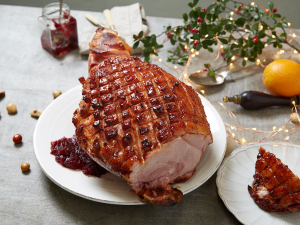Canterbury farmer Sean Molloy joins New Zealand Pork board
Following a recent director election, Canterbury farmer Sean Molloy has been appointed to the New Zealand Pork Industry Board.
 NZPork is asking Kiwis to make sure they are buying New Zealand pork over imported pork this Christmas.
NZPork is asking Kiwis to make sure they are buying New Zealand pork over imported pork this Christmas.
As Kiwis order their Christmas ham, NZPork is encouraging them to check the pork is actually from New Zealand.
Almost 41,000 metric tonnes (MT) of pork has been imported from 31 countries so far during 2021. Most will be further processed in New Zealand, with some labelled as Kiwi-grown pork.
The product labels, which highlight the New Zealand manufacturer rather than the origin of the pork, feature “made in New Zealand” descriptions with “from local and imported ingredients”, sometimes in fine print.
“More than 60% of the pork products consumed in New Zealand is imported from overseas, and for cured products such as bacon and ham, it’s even higher at up to 85%,” says David Baines, chief executive of NZPork.
“A lot of imported pork is produced using practices illegal in New Zealand and no Kiwi wants to think about that over Christmas.
“That’s why when New Zealanders spot a ‘made in New Zealand with local and imported ingredients’ label, they need to know there’s a good chance it has been imported.”
New Zealand’s pork sector operates to high welfare standards compared to many other countries who have less rigorous welfare and environmental regimes, says Baines.
“Our pig farmers are also proud of the high health status of pigs in New Zealand. Our animals aren’t affected by diseases that are impacting pork industries in many other countries.
“New Zealand does not import live pigs but these viruses can enter the country on infected meat. While they are harmless to humans, they could be spread to pigs in the wild or other kinds of farms or lifestyle blocks through infected food scraps – and ultimately be transmitted to the commercial herd.”
So far during 2021, most pork imports have come from Germany, Poland, Australia, Canada, Spain, the United States and Finland.
New Zealand needs a new healthcare model to address rising rates of obesity in rural communities, with the current system leaving many patients unable to access effective treatment or long-term support, warn GPs.
Southland farmers are being urged to put safety first, following a spike in tip offs about risky handling of wind-damaged trees
Third-generation Ashburton dairy farmers TJ and Mark Stewart are no strangers to adapting and evolving.
When American retail giant Cosco came to audit Open Country Dairy’s new butter plant at the Waharoa site and give the green light to supply their American stores, they allowed themselves a week for the exercise.
Fonterra chair Peter McBride says the divestment of Mainland Group is their last significant asset sale and signals the end of structural changes.
Thirty years ago, as a young sharemilker, former Waikato farmer Snow Chubb realised he was bucking a trend when he started planting trees to provide shade for his cows, but he knew the animals would appreciate what he was doing.

OPINION: Your old mate welcomes the proposed changes to local government but notes it drew responses that ranged from the reasonable…
OPINION: A press release from the oxygen thieves running the hot air symposium on climate change, known as COP30, grabbed your…